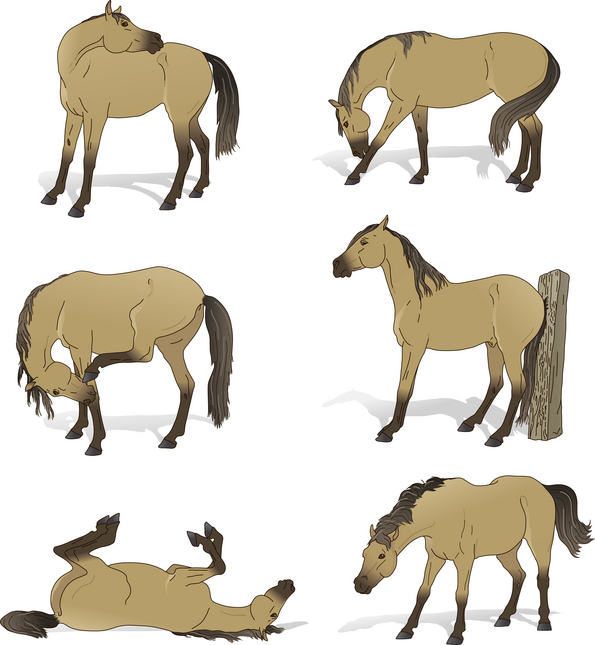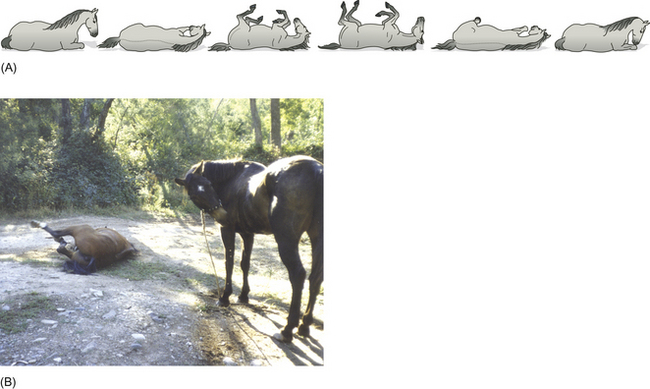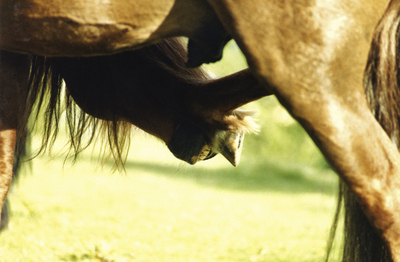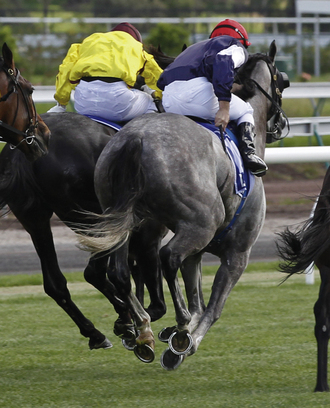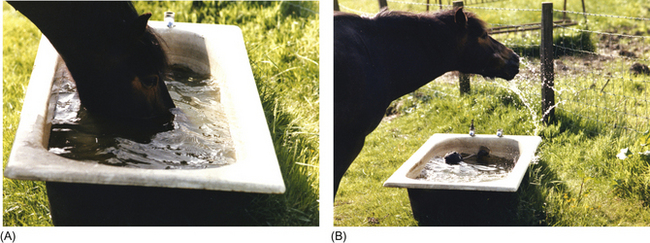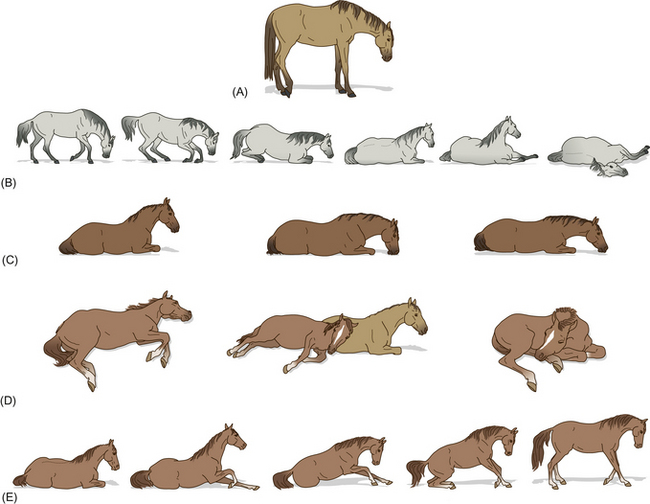Chapter 10 Body care
Grooming
In addition to maintaining integument health, grooming behaviors can contribute to affirming social bonds not least by reinforcing affiliations and sharing odors. Evidence that body odors prompt horses to undertake longer investigative sniffing than either urine or feces1 should remind us that horses rely chiefly on scent to recognize familiar conspecifics once they are close.
Mutual grooming
Mutual grooming not only allows horses to reach areas that defy self-grooming strategies, but also facilitates exchange of odors2 and has been shown to reduce heart rate when conducted in certain parts of the mane and withers.3 Grooming of withers by humans has a similar calming effect.4 The effects on cardiac function are particularly striking in foals, with a mean reduction of 14% in heart rate being reported when preferred areas were scratched by humans.3 This phenomenon is regularly harnessed by personnel who want to reward horses of any age without using food.
Mutual grooming can begin in the first week of life5,6 but peaks in the second and third months of life,7 a period during which foals seem to find physical contact intensely gratifying. In the first instance the foal’s mutual grooming partner is its dam, who may dismiss other grooming partners if her foal solicits her attention by attempting to allogroom.5 Although some mature horses never allogroom, most regularly indulge in reciprocated activity of this sort with favored affiliates for periods of about three minutes at a time.8 Broadly speaking, regardless of their age, females spend more time mutually grooming than males. Mutual grooming partners are usually preferred associates that are close in social rank.9 In a natal band, mares and their offspring mutually groom kin rather than unrelated conspecifics.10 The absence of a stallion seems to bring with it some liberation in that grooming partners are preferentially from same sex-age groups.11 The stallions in multi-stallion harems will mutually groom one another.12
Mutual grooming often starts at the cranial neck and proceeds to the withers (Fig. 10.1), the shoulders and then to the tail-head, sometimes changing sides (see Fig. 2.15).13 While youngsters often attempt to begin allogrooming, such overtures are rarely reciprocated by unrelated adults.5 As discussed in Chapter 5, there is equivocal evidence for the role of rank when a bout of mutual grooming begins.5,11 Reports indicate that low-ranking individuals groom more and initiate more groomings and that allogrooming may have a role in appeasement.12 However, most bouts are ended by the departure of the higher-ranking member of the dyad.5 Mutual grooming between foals is often observed before or after a bout of play.14
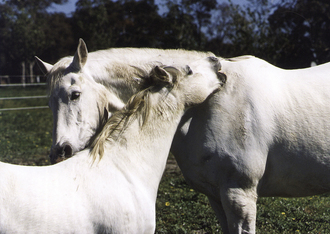
Figure 10.1 Mutual grooming helps equids to develop and maintain pair bonds.
(Photograph courtesy of Sandra Hannan.)
The frequency of mutual grooming is subject to daily and seasonal variation, with predictable troughs that coincide with recumbency.15 Shedding the winter coat and the seasonal peak in idling behavior account for annual peaks in mutual grooming (i.e. April and July in northern hemisphere studies5). When allowed to interact freely with other horses after 9 months of social deprivation, colts stabled singly showed significantly more social grooming than colts stabled in groups, which may reflect a build-up of motivation (a post-inhibitory rebound effect).16
Self-grooming
Self-grooming brings out a great deal of resourcefulness in horses as they use their hooves, their mouths and objects in their environment to relieve irritation (Fig. 10.2). The frequency of self-grooming peaks at 12.3 times per hour in weeks 5–8 of a foal’s life.17 The relative proportion of body parts and the innate flexibility of foals both help to explain their relatively enhanced ability to self-groom and may account for the decline in frequency of self-grooming to 1.2–2.2 times per hour in adults.18 While their dams focus self-grooming on rolling and rubbing against the forelimbs, conspecifics or inanimate objects, foals are more frequently found scratching anteriorly with their hindlimbs or nibbling posteriorly.17
Along with appetite and growth, pelage cycles are related to the duration of the photoperiod.18 Therefore the amount of self-grooming peaks with the shedding of the winter coat.
Scratching by humans can act as a highly valuable primary reinforcer, so an appreciation of the pleasure that grooming may bring can help to consolidate the horse–human bond. However, grooming by humans must take account of the variable sensitivity of different individuals and breeds.2 The need to have a clean horse has been overstated by some horse-care manuals. Further, the perceived need to pull manes and tails undoubtedly irritates many horses and possibly compromises the horse–handler bond.
Rolling
Because preferred substrates are sand, fine dry soil and occasionally mud, horses at pasture tend to select bare patches on which to roll, often beside gates or water troughs.19 Some feral horses have been observed to roll preferentially in water.8 With more than 80% of rolling occurring where another horse has rolled,2 its function is believed to include the opportunity to deposit scent over the body. The fact that horses, especially males,20 smell chosen sites before and after rolling appears to support this view.
The head and neck help to propel the horse laterally while rolling (Fig. 10.3).13 Similarly, lateral flexion of the vertebral column and thrashing of hindlegs seems to help the horse to balance itself on the dorsal midline.13 Rolling horses usually return to the same side they started lying on but often repeat the roll before rising.13
The physical environment can affect horses’ inclination to get down onto the ground. For example, there is evidence that small boxes inhibit sternal recumbency.21 Apart from some foaling boxes, the space on the floor of most stables and many custom-built sand rolls is less than the width of most natural rolling sites. This helps to explain why we should be pleased that more horses do not get cast (stuck against the walls of stables or upside down in their stables). The use of anti-casting rails is a measure believed to help inverted horses to right themselves when stuck against the side of a stable. These rails are set about one meter from the floor, although their height should, strictly speaking, depend on that of the occupant. They work by providing some purchase against which the horse can push in a bid to move itself away from the wall.
Bedding materials such as straw that lend themselves to being banked up against the side of the stable wall are likely to reduce the risk of casting. Whatever bedding is selected must be managed carefully to maintain air hygiene. Beds that drain readily are less likely to be accompanied by high ammonia concentrations or allow humidity to rise to concentrations that increase the viability of fungal spores implicated in lower-airway disease.22 Bedding preference studies suggest that the appeal of straw depends on its being deep and is linked to its alternative use as a source of dietary fiber.23,24
Shaking
Shaking is frequently seen after untacking, rolling and recumbency. It involves coordinated contraction of the superficial musculature that travels caudally from the head leading to vibration and rotation of the skin on the body. The neck is lowered prior to shaking,13 and a wide placement of the forelegs is assumed. Males and non-estrous females often shake after urinating.13
Rubbing
Rubbing can involve fixed objects or the muzzle.13 The latter is used to reach places, such as the barrel and forelegs, that are hard to rub against fixed objects. Foals may rub target areas, such as the head, neck, croup and buttocks, on objects for as long as 15 minutes at a time.13 Less frequently horses are observed using low branches to rub their backs and may sometimes straddle vegetation on which they rub their ventral surface by walking forwards and backwards.13 Rubbing the vulva, tail and buttocks has been recorded in mares,13 with accompanying signs of pleasure, such as lip quivering, suggestive of masturbation.5
Scratching
After turning its head and neck to the rear, a horse can use its hindlimbs to scratch parts of the cranial and anterior cervical region. More common in foals than in adults,17 this response is thought to be retained by more ponies than horses.13 Indeed, some lice-ridden ponies may go on to insert a pastern into the mouth and proceed to mumble on the limb.25
Nibbling and licking
The use of teeth in body care varies from a rhythmic scratching action by the upper incisors, to small bites. While the areas that can be reached by the teeth include the sides and loins (see self-mutilation in Ch. 11) and even the hindlegs (Fig. 10.4), the forelegs seem to receive especially detailed attention that incorporates considerable licking. This is a means of removing bot eggs from the hairs that effectively facilitates their ingestion. Although licking seldom occurs as part of mutual grooming,13 the licking of a neonate by its dam is probably the most important instance of a horse using its tongue during grooming a conspecific. This can last for 30 minutes and, as well as consolidating the mother–infant bond, it provides tactile stimuli that may have a role in stimulating responses such as standing. Licking by a stallion as part of courtship is a means of tasting rather than grooming.
Pest avoidance
Flies bite and spread diseases, such as conjunctival infections, and proteins in the saliva of Culicoides spp. are the stimuli responsible for the often grotesque self-mutilation of sweet itch (Queensland itch, summer itch, summer eczema). Apart from ill-advised excoriation, horses have developed adaptive behavioral responses to combat pests. For example, in foals, the percutaneous invasion of the third-stage larvae of Strongyloides westeri is reported to cause repeated episodes of frenzied behavior lasting about 30 minutes.26 The energy expended in motor responses such as tail-swishing to reduce irritation of insect origin may be considerable, and movement to areas (such as cooler parts of the home range) that provide respite may therefore be seen as forms of energy conservation.27 Tabanid flies drive free-ranging Camargue horses to change their time-budgets and use of their home ranges, apparently in a bid to capitalize on the prevailing winds in key areas.28 Similarly, Assateague ponies have been noted to use inshore water and snow patches as refuges from tabanids.27 For horses, insects are not the only airborne pest. Avoidance measures have also been demonstrated in response to the vocalization of vampire bats.29
With pliable, mobile skin and extensive subcutaneous muscles, horses are among the best skin-twitching animals. The sensitivity of horse skin, for example, to alighting flies as they stimulate the panniculus response, should serve to remind riders how little pressure is needed for signaling and how heavy whip use can compromise welfare (Fig. 10.5). Riding instructors who find themselves telling their pupils to kick their mounts should consider the lesson they are providing for both rider and horse. While stamping, kicking and shaking of the whole body or head are all employed to dislodge insects, the forelock and the tail can act both as screens and swats in combating fly problems. The effectiveness of mutual tail-swishing as a means of reducing the harm caused by flies is reflected by there being demonstrably fewer bites per horse in animals that live in large groups.30 Horses frequently swing their heads in the direction of flies on their flanks in a motor pattern similar to an agonistic head threat that occasionally includes a consummative nip at their own skin.13 Along with pawing, tail-swishing increases with ambient temperature in horses while being prepared for work.31 Since this effect is not a function of fly numbers, it has been suggested that such comfort behaviors may be useful indicators of irritation in horses, especially where ambient temperatures are high.31
The use of other horses’ tails in helping to reduce the frustration of flies on the face is established in foalhood as foals frequently rest within the shelter of their dams’ swatting tails.7 The solitary housing of horses denies them this facility and should oblige owners to provide such animals with some form of screen. The importance of the tail in body care is implied by reports of horses with docked tails occasionally using sticks to scratch their sides.32 Veterinarians who prioritize the welfare of animals in their care recognize the function of the tail as a source of comfort and therefore do not dock horses for cosmetic reasons.
Behavioral thermoregulation
Horses often surprise owners with their reluctance to use field shelters. This rejection of enclosed space relates to their dislike of confinement and reduced surveillance and visual contact with conspecifics. That said, horses are often seen using shaded areas, natural windbreaks, sun-baking and occasionally wading in water to regulate their body temperature. Evaporative heat losses are thought to be increased by the sprinkling effect of tail-swishing while standing in water33 and by the occasional instances of nose-dunking in water (Fig. 10.6). Thermoregulation is often made difficult by rugs, especially in warm weather when rugs are sometimes used to prevent sun-bleaching. Discomfort caused by over-heating, skin disorders and generally badly fitted rugs may prompt some horses to become rug chewers. Other horses, especially youngsters, may adopt this response as a form of object play.
Rest and sleep
Fraser34 identifies four resting states: idling, resting, drowsing and sleeping. He also gives a detailed account of pandiculation (stretching) elsewhere.34
Idling is adopted as a passive waiting style between more animated activities and involves stationary standing with some limb-shifting and positional changes. It can occur as a group activity, in contrast to recumbent sleep, which is rarely undertaken by all the members of a group at one time.35 Seasonal peaks in resting behaviors occur in the summer5 when forage is relatively plentiful and there is pressure to seek shade and avoid insects. Common sites are usually selected for lying, a behavioral mechanism thought to help produce a group odor.2 Elevated sites are often selected since they provide refuge from heat and flies.36 Resting occurs in the standing or recumbent position and in the wakeful periods between sleep and drowsing. Generally, light horses spend less time standing to rest than draft types.37
Drowsing
A drowsing horse stands with its eyelids partly opened and its head hanging at a medium height (Fig. 10.7). The flexion of a single hindlimb is facilitated by the reciprocal apparatus in the hindlimb, which means that movements of the stifle joint drive those of the hock.38 Thus, once the stifle is fixed in position, the hock is obliged to follow suit. In combination with the stay apparatus found in the forelimb as a means of supporting the fetlock, this allows the horse to remain upright with a minimum of muscular effort. The advantages of remaining standing include being able to achieve a quick escape if threatened, but also to avoid cardiorespiratory compromise that comes with recumbency. Interestingly, adopting certain postures for rest has been shown to have familial tendencies.39
Sleep
The distinction between drowsing and sleep necessitates understanding the different physiological characteristics of various states of wakefulness. In adult horses, sleep occupies 3–5 hours per day, while drowsing consumes a further 2 hours.40 Postural changes tend to accompany certain states – for example, although the eyes remain partly open, the head gradually descends as the horse goes from drowsing to sleep.36 Animals may rest without sleeping and while the distinction between drowsiness and sleep is reasonably subtle, since they may appear very similar externally, electrophysiological studies of animals in various stages of sensitivity to their environment have helped to unpick the differences. Although such measurements require subjects to be restrained, we can assume that the same differences apply in unrestrained horses. Using data extrapolated from restrained subjects, inferences can be made from the posture of horses indulging in various rest behaviors.
The two types of sleep clearly defined in horses are slow-wave sleep (SWS) and rapid-eye-movement (REM) sleep (also known as deep or paradoxical sleep).40 The electroencephalogram (EEG) waves of SWS, as the name suggests, are characterized by a low frequency, a feature that disappears as the horse drifts into REM sleep. Some muscular tone is retained in SWS, even when the head is resting on the ground during sternal recumbency. It is the only form of sleep that occurs in standing horses. Although it may increase in horses that are unable or reluctant to lie down, SWS cannot compensate for lost REM. This is illustrated by post-inhibitory rebound in REM sleep after periods without recumbency.40 Along with the suggestion that horses do not lie down unless they are confident about their surroundings,35,40 this accounts for some of the concerns for the welfare of horses that do not or cannot lie down.41
REM sleep was dubbed paradoxical because, while its EEG is similar to that of wakefulness (Fig. 10.8A), it has the highest arousal threshold. Cardiac and respiratory rates decrease in all forms of sleep.42 REM sleep is peculiar in that it involves the absence of postural tone (and therefore the eyes are shut). It occurs entirely during recumbency and is marked by the greatest degree of variability in cardiac and respiratory frequencies of any state, including wakefulness. As its name implies, REM sleep is also often accompanied by rapid eye movements. In REM sleep during lateral recumbency, limb movements, especially of the upper limbs, may occur.13
Stay updated, free articles. Join our Telegram channel

Full access? Get Clinical Tree


